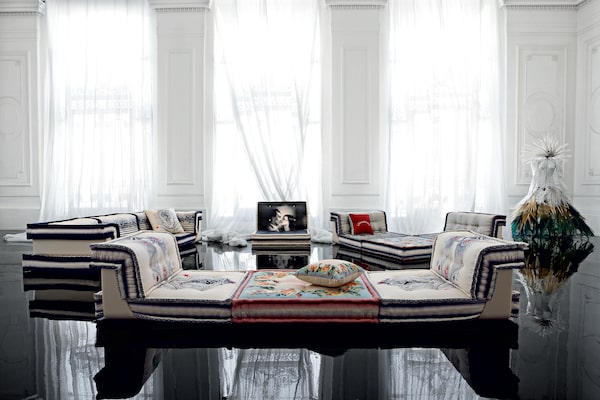
Roche Bobois creative director Nicholas Roche.Handout
Nicolas Roche likes to name drop. It’s an occupational hazard, not a tacky habit, and understandable given his role as creative director for Roche Bobois. The French furniture brand, which is marking 60 years in business in 2020, is known for two things: whimsical style and ritzy collaborations. “When the brand turned 50, 10 years ago, I had the opportunity to work with Jean Paul Gaultier,” he says, real casual, as though he’s talking about his barista. “It was wonderful to be a part of his fantasy for a while. Also because he understands fabrics so well. Just like Kenzo. That’s one of the benefits of working with fashion designers.”
Another name drop: Drake personally selected the Gaultier sofa, a blue-and-white, sailor-striped sectional, a few years ago. Drake was shopping with his interior designer, Antonio Tadrissi, to outfit a Miami condo but they were in Roche Bobois’s Toronto store, an important location for the company. “We opened in Canada in 1973,” he says, “Before America. Canadians have been such consistent supporters. Maybe because so many speak French, they understand our love of l’art de vivre Francais.”
Quirky, contemporary French style was not part of Roche Bobois’s origin story. The company has roots dating back to 1950, when Nicolas’s grandfather, Jacques Roche, opened a furniture and appliance store to help Parisians refurnish after the war. Most of the products were imported from Scandinavia, not designed in-house, and knocked off Bauhaus minimalism. The clean-lined functionalism was a reaction to Le Moustache, a pejorative referring to France’s then old-fashioned, frill-filled design aesthetic.
Roche Bobois dates to 1960, when Nicolas’s father François and uncle Philippe joined Jacques and brought on two partners, Jean-Claude and Patrick Chouchan. The Chouchans owned a furniture store called Au Beau Bois (beautiful wood), and the names were shortened and combined into Roche Bobois. All five were invested in a new, contemporary style, moving away from mid-century modernism towards the exuberance of the 1960s and 1970s. Instead of importing products, they decided to create fresh pieces with the best furniture designers of the day, including legends such as Pierre Paulin.
From the early days, Roche Bobois’s most recognizable holdover is the Mah Jong sofa, so-called because it’s an assemblage of square-shaped cushions that can be moved around and rearranged like mahjong tiles. German furniture designer Hans Hoper created the piece in 1971, reflecting an era when low-slung, super-wide, ultra-plush seating was becoming popular. “Mah Jong is still our best seller,” Roche says. “We have sold over 600,000 of them over the years.”

Roche Bobois’s most recognizable holdover is the Mah Jong sofa, seen here.Photo Roche Bobois/Handout
Roche didn’t always want to work for the family firm. For the first 20 years of his career, he was an architect and only joined Roche Bobois in 2005 after his father started musing about retiring. Since then, he’s helped grow the brand by extending the roster of collaborators. In addition to Kenzo Takada and Gautier, he’s also worked with other fashion designers including Christian Lacroix (on a zebra-meets-Rococo set of chairs perfect for the Mad Hatter’s tea party) and starchitects such as Jean Nouvel (a midnight blue table that looks a bit like a UFO). “With Nicolas Roche, we share common values of imagination and fantasy,” says Gabriele Chiave, creative director at Marcel Wanders, another partner. “He allowed us to create a collection anchored in a theme of travel, and translated our designs perfectly and beautifully.”
Under Roche’s direction, the company saw global sales grow to €260-million (about $400-million) in 2018, but he doesn’t attribute all that success to its bold-faced connections. “I look for talent everywhere,” he says. “I couldn’t only work with fashion designers – that would be ridiculous.” In 2020, to mark the brand’s six decades, he’s working on a special collection with Portuguese artist Joana Vasconcelos.
One of the greatest hits of Roche’s tenure is the AVA chair, a swooping Lucite seat that was designed in 2009 by Song Wen Zhong, who at the time was a 26-year-old recent design graduate. Roche encountered Zhong while hosting a design competition in China. “Zhong was so young and inexperienced,” says Roche. “He and I didn’t speak any languages in common. We had to write back and forth through a translator, or communicate through drawings. But we’ve now sold over 100,000 AVA chairs.”

The AVA chair.Handout
“His creative direction is constantly challenging what’s possible and pushing boundaries,” says Chris Wright, the founding partner of Toronto’s figure3 interior design, who has known Roche for almost 20 years. “He fearlessly experiments with new materials and manufacturing techniques, and yet maintains exceptional craftsmanship and quality.”
For Roche Bobois’s next chapter, Roche is focused on expanding customization and sustainability. “There’s no reason design can’t be more environmentally friendly and special,” he says. “I just don’t see it.”
Throughout the fall, new features from The Globe and Mail Style Advisor magazine will be appearing on Saturdays in The Globe and Mail. Subscribers can find the magazine’s holiday edition in The Globe on Nov. 20 and catch up on back issues online at tgam.ca/styleadvisor.
Sign up for the weekly Style newsletter, your guide to fashion, beauty and design, and follow us on Instagram @globestyle.